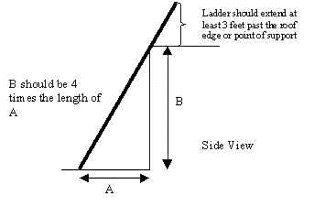[FONT=Verdana, Arial, Helvetica][size=2]Hi To all,
Rick Bunzel wrote this article which appeared on The Inspectors Journal site, he was kind enough to allow me to republish it here, in the light of accidents befallen to 2 of our members recently, we should all read this carefully.
Thanks Rick
[/size][/FONT][FONT=Verdana, Arial, Helvetica][size=2]
[/size][/FONT][FONT=Verdana, Arial, Helvetica][size=2] Most of us believe that an accident during an inspection will never happen to us. However think back over the past months as to how many close calls you have had? How many times has the ladder jumped around while we were going into the attic? Or when the ladder shifts when you’re stepping back onto your roof ladder?
Portable ladders are one of the handiest, simplest tools we use. Because of their simplicity we use them without a lot of thought. Each year in the U.S., accidents involving ladders cause an estimated 300 deaths and 130,000 injuries requiring emergency medical attention. As a fireman and a home inspector, I use ladders on a regular basis and it is easy to take them for granted. I have deliberate steps I take every time I set my ladder up to maintain my safety.
The majority of ladder accidents are caused by improper selection and use. Some of the more common hazards involving ladders, such as instability, electrical shock, and falls, can be easily prevented. Prevention requires proper planning, correct ladder selection, safe work procedures.
Always look at where you are going to use your ladder.
I look for trees
http://www.inspectorsjournal.com/forum/uploads/hausdok/200631184116_BigLadder.JPG
, electrical wires and other overhead
obstacles. The ground where you are raising the ladder should be relatively flat and offer good traction to the ladder feet. If you are raising an extension or multi-purpose ladder to the roof, always try to extend it at least 3 feet above the roof edge. Make sure the ladder extension locks or dogs are locked and tie the rope around the rungs. On multipurpose ladders the locks should be engaged.
The foot of the ladder should be spaced 1 foot away for every 4 feet it reaches up. An easy way to check the angle is to stand with your feet against the base of the ladder and extend your arms toward the ladder. If you have the correct angle, your hands should easily grasp the rungs. If it is a windy day take a bungee cord with you and wrap the bungee around the top rungs and attach to the gutter. This ensures a strong gust won’t blow down your ladder. Three points of contact is the rule for climbing or descending a ladder. Hold on with both hands when going up or down. If the client or realtor is available have them steady the ladder while you are on it.
Check the soles of your shoes before climbing. Mud or debris can turn into a lubricant at the wrong time. If you have to climb a steep roof, use the valleys, as they seem to offer a better surface for climbing and descending. I wear mechanics gloves during roof and crawl space inspections. On a hot day the shingles and flashing are 130+ degrees. I learned this the hard way one when I was getting back onto my ladder and put my hand down on a shingle. That was the last time I went up without gloves!
Seven Tips For Ladder Safety:
-
- Beware of the electrical lines. When you are on the ladder or working on the roof. They may look innocent but can cause severe shock and injury.
-
Do not stand on the ladder’s top three rungs. Do not work from the top or top step of a stepladder.
-
Take time to evaluate your ascension. Look at all slopes and valleys. Two and three story structures call for the utmost of attention and care. Pulling your ladder up on to a one-story roof to get to the second story is risky, as normally you will be placing the foot of the ladder onto a sloped surface. This one will get you if you don’t exercise good judgment. If you have to do this climb, get someone to hold the ladder in place, better yet, get a longer ladder and avoid the situation!
-
Ladders used to reach a roof should extend beyond the roof edge preferable 3 feet. With my Little Giant I make an exception due to the spread legs as they make it difficult to step onto the center of the rungs. I usually only raise it a foot or so above the roofline.
-
On the roof always be moving deliberately. Always looking at where you’re stepping especially when you’re backing up. The next step could be off the roof or cause you to go off balance.
-
Always have 3-point contact (such as, one hand and two feet) with the ladder.
-
Keep your body centered between the side rails of the ladder – so you don’t tip over the ladder. Never use a ladder that has been damaged.
Lastly, if you are going to work on your roof, beware of the pitch or angle of the roof. It is always easier to walk up the roof than down it. I never walk on metal, tile or slate roofs and rarely on wood shake roof. I also rarely will walk on a wet or snowy roof. Those surfaces offer questionable traction and if I run into a problem I want all the traction I call get. This is my personal preface, which I am sure some people will disagree with but I back it up with 30 years experience as a firefighter. As a firefighter we use ladders in all types of conditions and only take risks when lives are on the line. We train with safety in mind to minimize the risks.
If the roof looks pretty steep when you get to the top of your ladder, then it may not be safe for you. If your nervous and your body is sending out danger signals, then exercise your right to call the climb unsafe for you. It’s better to say no than to risk getting hurt or killed. In 2004, Rich Norris, a home inspector in San Diego fell off a roof and died from his injuries. I sustained an injury falling off my own gazebo last spring. I fell 15 ft. to a wooden deck and couldn’t work for 2 weeks. I was lucky; I didn’t break any bones and only separated a shoulder. When you own your own business and can’t work, your income stops. The bottom line is don’t take unnecessary chances. Be safe!
Rick Bunzel is the Principle Inspector at Pacific Crest Inspections and a Firefighter with the Mt. Erie Fire Department
Rick can be contacted at Pacific Crest Inspections @ 360-588-6956 or Rick@PacCrestInspections.com.
For discussions about other inspection-related topics on TIJ’s Other Forums. [/size][/FONT]





